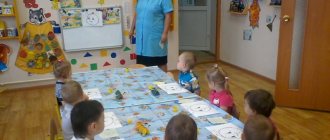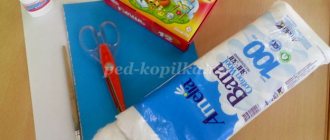Lexical topic: “Insects” Fizminutka. Finger gymnastics
Transcript
1 Lexical topic: “Insects” Physical exercise Chock chock, heel! (stomp your feet) The cricket spins in a dance. (spin) And the grasshopper, without a mistake, performs a waltz on the violin. (moves with his hands, as when playing the violin) The wings of the butterfly flicker (moves with his hands, like wings) She flutters with an ant. (twirl in pairs) Hands clap loudly! (clap your hands) That's it! Tired legs! “Bee” Finger gymnastics A striped bee flew to us yesterday, waving its palms. For each name of an insect, a bumblebee-bumblebee bends a finger behind it. And a cheerful moth, two beetles and a dragonfly, eyes like lanterns. Make circles from your fingers and bring them to your eyes. They buzzed, flew, and fell from fatigue. They drop their palms on the table. “Beetle” Breathing exercises The child sits, arms down along the body. Raise your arms to the sides and move them back a little, inhale. Exhaling, show how long the big beetle [zh] is buzzing, while simultaneously lowering your hands down. “Mosquito” The child sits with his legs wrapped around the legs of the chair. Hands on the belt. You need to take a breath, slowly turn your torso to the side; as you exhale, show how the elusive mosquito [z] rings, quickly return to the starting position; take a new breath and turn in the other direction. “Whose butterfly will fly farther?” Blowing away butterflies.
2 Tasks for fine motor skills “Beautiful dandelion” - sticking matches into a plasticine lump. Drawing up cut-out pictures. Collective work “Spring Meadow” - crumple small colored pieces of paper, squeeze tightly in a fist, roll between your palms and glue to a common green background. “Nasty flies” - making a fly curtain: cut a sheet of paper into even strips, not all the way. “Magic Flowers” - work with a variety of mosaics. Everyone puts out their own flower.
3 Monday Children must learn: the basic names of insects; where they live, what they eat; what are they needed for. The fourth odd one": ant, rook, bee, beetle; dragonfly, beetle, caterpillar, dog; mosquito, grasshopper, butterfly, squirrel, cockroach, mosquito, sparrow, ant, hare, hedgehog, fox, bumblebee; wagtail, beetle, starling, magpie; butterfly, dragonfly, raccoon, bee; "Count 1-5." (Mosquito, grasshopper, butterfly, fly, ant, etc.) “Call it affectionately.” Mosquito mosquito. Dragonfly, bee, beetle, ant, caterpillar. Game “What insects are hidden in the picture?” Goals: develop visual attention; form the grammatical structure of speech, learn to correctly use nouns in the accusative singular form. Progress of the game. The teacher invites the children to carefully look at the picture and name who they see in it. Children must answer in complete sentences. For example: I see a dragonfly, a grasshopper in the picture...
4 Tuesday Lifestyle of insects; what do they eat; insect camouflage; their structure (head, mustache, wings, six legs or eight for a spider); where they live (mink, beehive, hollow, anthill); their harm and benefit. “Slap the words.” Syllabic analysis of words: caterpillar, grasshoppers, anthill, centipede, beetle, butterfly, fly. Game “Words are enemies” Put on Break Raise Give Praise Lie Pour Hide Take away Fall Turn on Search Love - Scream
5 Wednesday “Pick up a word” Selection of verbs for the word insects: fly, flutter, crawl, jump, suck, bite, sting, collect, drink, buzz, ring, buzz, bother, harm, help, fly, hide, fall asleep, wake up, they get out, work, endure. Pure sayings: FOR FOR FOR FOR - the dragonfly has arrived OZY OZY OZY long-winged dragonflies KI KI KI - horned beetles KI KI KI - beetles are crawling WHACK WHACK WHACK - here a worm crawls LA LA LA a bee sits on a flower SA SA SA - striped wasp SU SU SU - no we are afraid of the wasp WEI WEI WEI - red ant OL OL OL green mantis ANY ANY ANA - big cockroaches CHI CHI CHI cockroaches longhorned beetles TKE TKE TKE - a butterfly on a flower OH OH OH - a lot of flies EAR OW OW a fly has arrived OH OH OH birds catch flies PY PY PY funny bugs
6 Thursday Clap each syllable: Tongue twisters: “Centipedes have too many legs” Counting books: “There lived a cricket behind the stove, His heels clinked and clinked. But the heel broke, and there was silence behind the stove.” “Who moves how?” Composing complex sentences with the meaning of opposition. An ant crawls, and a butterfly... A caterpillar crawls, and a grasshopper... A butterfly flies, and a snail... A beetle crawls, and a dragonfly... A wasp flies, and a worm... A snail crawls, and a dragonfly... A spider crawls, and a bee... A wasp flies, and a worm... A grasshopper jumps , and the mosquito...
7 Friday Conversation on a subject picture about a bee. Who is in the picture? What bee? (Small, striped, hardworking.) What sound does it make when flying? Name the body parts of a bee (together with the teacher). Where does the bee live? How does he move? What does it eat? Does it benefit or harm the environment? What benefit or harm does it bring to a person? What does he do in winter? Whose honey is produced by bees? (Bee.) What is the name of the family of bees? (Bee.) What does a bee do? (Carries honey.) “Who meows, who grunts?” Cooing (who?) Clucking? Quacks? Knocking? Chirps? Meowing? Buzzing? Growls? Chirping? Cackling? Is it croaking? Howling? Grunts? Laughing?



